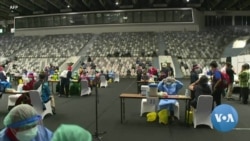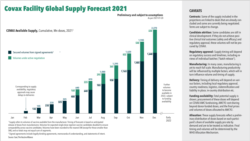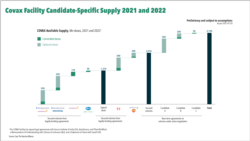The Biden administration on Thursday underscored the importance of supporting COVAX, the global mechanism that aims to deliver coronavirus vaccines to poor countries, but it acknowledged it has not increased funding beyond the $4 billion approved in December for Gavi, the Vaccine Alliance, one of the co-leaders of COVAX.
“We have reiterated our commitment to COVAX, and I don’t have any additional funding note to announce today,” White House press secretary Jen Psaki said in response to a question from VOA.
On Jan. 21, the day after President Joe Biden was inaugurated, the U.S. announced it would join COVAX and rejoin the World Health Organization. In July 2020, then-President Donald Trump formally withdrew from the world body, accusing it of being a puppet of China during the pandemic.
A White House spokesperson told VOA that the administration is working with agencies and international partners on the formal steps needed to rejoin WHO and COVAX.
“Our imperative at the moment is ensuring our supply is and will continue to be sufficient here at home,” the spokesperson said. “At the same time, it is absolutely our policy and our understanding that we need to engage and be helpful to the global community in the pandemic response.”
Biden highlighted the message of working together with the international community in his foreign policy speech Thursday.
"We've also reengaged with the World Health Organization,” Biden said. “That way we can build better global preparedness to counter COVID-19, as well as detect and prevent future pandemics, because there will be more."
Still, the administration has provided little detail on the scope and scale of U.S. commitment to COVAX beyond an initial National Security Directive released on Jan. 21 addressing U.S. global leadership to strengthen the international pandemic response.
The directive instructs officials to come up with a framework for donating surplus vaccines, once there is sufficient supply domestically, to countries in need including through the COVAX facility.
What is COVAX?
COVAX is a global initiative co-led by the World Health Organization, Gavi, the Vaccine Alliance, and the Coalition for Epidemic Preparedness Innovations. It aims to deliver 2 billion doses of the coronavirus vaccines to people in lower-income countries by the end of 2021.
As wealthy countries build up stockpiles for their own populations, the goal of COVAX is to ensure that poor countries can vaccinate at least 20% of their people.
On Wednesday, COVAX announced its forecast of the first batch of vaccine distribution.
“Soon, we'll be able to start delivering life-saving vaccines globally, an outcome we know is essential if we're to have any chance of being able to beat this pandemic,” Seth Berkley, CEO of Gavi, the Vaccine Alliance, said in a briefing to reporters.
According to COVAX interim forecast data, the first batch of vaccines distributed will include 336 million doses of the AstraZeneca vaccine in the first half of this year and 1.2 million doses of the Pfizer-BioNTech vaccine for the first quarter.
The 1.2 million is part of the 40 million doses Pfizer promised to COVAX this year. The company has obligations to individual countries, including the 200 million doses it promised to the United States by July.
Berkley expressed disappointment that COVAX received so few Pfizer shots.
“Of course, we would like more Pfizer-BioNTech. That is what we were offered,” he said, encouraging manufactures to make the largest number of doses available early to ensure global equitable distribution.
COVAX is part of the World Health Organization’s ACT Accelerator, a global collaboration to accelerate the development, production and equitable access to COVID-19 tests, treatments and vaccines.
First step
While welcomed by recipients, the total doses under COVAX cover on average only 3.3% of the total population of participating countries, merely a first step in the initiative’s goal of vaccinating 20% of the people in 92 lower-income countries, mostly in Africa, Asia and Latin America, by end of 2021.
“They're not finished, and so we're going to see much more from COVAX,” Bruce Gellin, president of Global Immunization at the Sabin Vaccine Institute, said.
“It was vaccines that were clearly available, that they had some control over and started to make those allocation projections primarily so countries could begin to plan,” Gellin said. The immunization strategy planning would include storage, distribution and how to address vaccine hesitancy.
To meet its target, COVAX will need to address not only the current lack of supply but funding. COVAX said it needs $4.9 billion, in addition to the $2.1 billion it has already raised.











